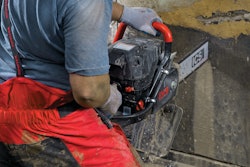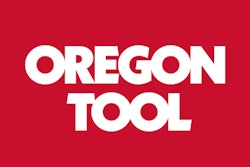
When it comes to concrete cutting performance, the blade or chain used can make all the difference. "It is important to use the proper chain/blade for the application," emphasizes Kent Johnston, regional sales, ICS Education & Market Development. "Using a blade or chain not recommended for an application will not only affect life, it will affect cutting speed."
Mike Ward, product manager - Power Cutters, Husqvarna Construction Products, agrees, noting, "If the wrong blade or chain selection is made, it will increase safety hazards, and the power cutter can potentially perform poorly and lose productivity - all of which a contractor wants to avoid."
Is higher quality required?
Diamond blades are available in several quality levels based on the number of diamond segments and the method used to adhere to the blade.
"Depending on the type/hardness of the aggregate, types of material to be cut (concrete, brick, block), amount of rebar and abrasive conditions, the type and quality of the segments is important," Johnston states. "Laser-welded segments with layered diamonds are more expensive than vacuum-brazed segments, but provide more life. The cost per inch-foot of cutting is important."
Diamond tool cost is usually measure in inch-feet, which is calculated by multiplying the length of the cut by its depth (e.g., 100 ft. x 4 in. deep = 400 in.-ft.), explains Richard Tremain, product manager - flat saws, Husqvarna Construction Products. "A higher quality blade will usually perform better and last longer than the lower quality blade, thus reducing the diamond tool cost," he adds.
"A premium blade is going to provide the best cost per inch-foot of cut," states Brian Delahaut, vice president/general manager, MK Diamond Products. However, he adds, "It really depends on the job and what the customer is willing to spend. Some of the standard blades today are very cost effective and provide excellent performance over that of a premium or supreme blade."
Job size can determine whether a premium blade is worth the investment. "If the job is rather small and you don't have a whole lot to cut, then there's no need to invest in an expensive premium blade," says Clark Swenson, Diamond Vantage.
Still, it's important to match blade quality to the application. "Knowing the job/application and working with your supplier will help you get the right blade," says Delahaut. "You trade something when you only use general-purpose blades and not a specific blade for the application."
Wet or dry?
Whether you're cutting wet or dry will also play a role in blade selection.
Because diamond blades grind rather than cut, they generate heat. As such, dry cutting requires the blade to backed out of the cut every few seconds to allow the blade to cool, Swenson points out. As a result, wet cutting tends to be more productive due to the ability for more continuous cutting. However, it requires a water source and may require disposal of the slurry produced during the cutting operation.
A dry cutting blade can be used in a wet cutting application, but the reverse isn't true.
"You can use a dry diamond blade wet anytime and it's beneficial. But that's a one-way street," says Swenson. "It has to do with the construction of the blade. The dry blades are designed to work in a higher temperature, and the wet ones are not. The hazard that comes into play is that when using a wet blade dry, the blade can lose segments and/or teeth, which become a flying object.
Consequently, do not use a wet blade for dry cutting applications, he advises.
Match speed for speed
"The first question when selecting a blade - which will dictate which series or type of blade you're buying - is what tool you're putting it on," Swenson notes. The rated blade speed should be properly matched to the speed rating of the saw to ensure optimal performance.
Tremain explains, "You would not want to use a blade designed to be used on a high-horsepower [flat] saw on a low-horsepower saw. If this happens, the blade could close up and stop cutting. On the other hand, you would not want to use a blade designed to be used on a low-horsepower saw on a high-horsepower saw. This could result in the blade wearing out very quickly - potentially even before the job is finished."
Your blade supplier can help ensure you properly match saw and blade speed. "Call the manufacturer and advise them how much and how deep you have to cut and what the horsepower of the saw is," says Delahaut, "and they will be happy to provide you with the right blade that will give you the best performance."


















